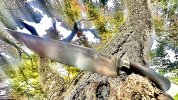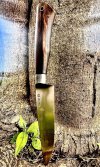CelloDan
Basic Member
- Joined
- Dec 2, 2017
- Messages
- 3,377
This one is my favourite 
I missed showing it in the above photo.
I like the bigger and flatter “spoon” like filter.
The holes on the filter are small which helps prevent clogging and there plenty of them.
The big spoon can be used to redistribute the yerba inside the gourd.
This type of bombilla is the type most used in Uruguay and Brazil.
The Yerba there tends to be more finely ground than the Argentine variety.

I have not received the blank yet.
I do look forward to “encabar” a criollo.
My skills and tools are basic but I think it will be a worthwhile experience to give it a try.
I am back on the water on my first solo trip of the year.
The view outside right now with a big moon that woke me up shining inside “Serena’s” cabin.

I missed showing it in the above photo.
I like the bigger and flatter “spoon” like filter.
The holes on the filter are small which helps prevent clogging and there plenty of them.
The big spoon can be used to redistribute the yerba inside the gourd.
This type of bombilla is the type most used in Uruguay and Brazil.
The Yerba there tends to be more finely ground than the Argentine variety.

I have not received the blank yet.
I do look forward to “encabar” a criollo.
My skills and tools are basic but I think it will be a worthwhile experience to give it a try.
I am back on the water on my first solo trip of the year.
The view outside right now with a big moon that woke me up shining inside “Serena’s” cabin.


 and knife number one too since we are at it
and knife number one too since we are at it 















